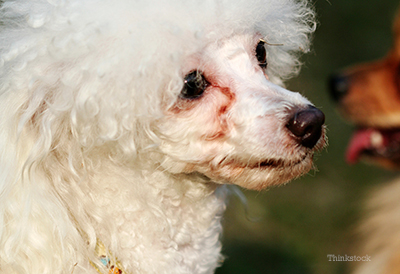
Have you ever noticed how many dogs have reddish brown staining of their fur? It occurs most commonly where tears moisten the fur around the dog’s eyes or around their mouth where saliva wets their fur as well as where they lick their feet and forelegs.
What is causing the stains in dogs?
This discoloration is caused by a chemical called porphyrin. Porphyrins are excreted primarily through bile and the intestinal tract, but in dogs a significant amount of porphyrin is excreted through tears, saliva and also urine. Saliva and tears contain substances called porphyrins, which stain light fur pink, red or brown. Porphyrins are a group of organic compounds of which many occur in nature. One of the best-known porphyrins is heme, the pigment in red blood cells. If you have ever noticed a white dog that has been licking or chewing on his leg, the hair in that area will turn iron-brown in color. The actual cause of stains is the porphyrin in the tears and saliva.
Why do stains occur in dogs?
Some dogs produce excessive tears – primarily because when humans turned wolves into today's best friend selective breeding created short noses and protruding eyes that contribute to abnormally narrow and often crooked tear ducts. Some medical conditions that result in excess tearing and licking are associated with the excess staining but are not the cause of the stain. In addition to allergies and irritants that may cause excess licking, anatomical problems such as ingrown eyelashes, entropion, abnormally small tear duct openings and irritants such as cigarette smoke may be causes1.
When porphyrins remain in contact with hair, particularly in white coats, for any time, the chemical stain develops. It is virtually impossible to remove once it develops.
Is porphyrin staining serious in dogs?
Fortunately, porphyrin staining is in itself a cosmetic problem and causes the dog no harm. However, the underlying or causative problem can be significant. Eyelid abnormalities may cause significant discomfort. Excess salivation may be caused by oral discomfort such as gum disease or dental problems. And dogs that lick and scratch their faces, feet, armpits and genitals frequently are affected by allergies that can cause distress.
If your dog is experiencing porphyrin staining be sure to have your veterinarian perform a complete physical examination to rule in or out these problems.
Can porphyrin staining be managed in dogs?
Obviously part of the answer is preventing the porphyrin containing fluids from remaining in contact with the hair. Regular cleaning can provide minimal help. Keeping long hair from rubbing in the eyes may also help keep the areas clean and dry.
How is staining treated in dogs?
Although somewhat unsightly, the staining caused by porphyrines is just that -- cosmetically unsightly. The stains cause no discomfort. Although in the past antibiotics have been used with mixed results to control staining, the use of antibiotics for a cosmetic problem cannot be recommended.
Questions to ask your veterinarian
- My dog’s eyes are stained with blood colored tears. What is causing the staining?
- What caused my dog’s feet to be stained red?
If you have any questions or concerns, you should always visit or call your veterinarian -- they are your best resource to ensure the health and well-being of your pets.
Resources:
